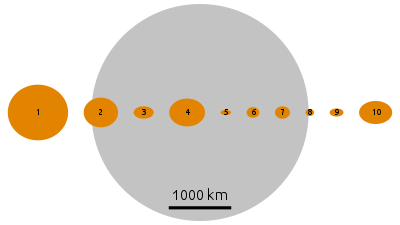3 Juno
[2] 'Juno' is the international name for the asteroid, subject to local variation: Italian Giunone, French Junon, Russian Юнона (Yunona), etc.Juno can reach +7.5 at a favourable opposition, which is brighter than Neptune or Titan, and is the reason for it being discovered before the larger asteroids Hygiea, Europa, Davida, and Interamnia.[11] Spectroscopic studies of the Junonian surface permit the conclusion that Juno could be the progenitor of chondrites, a common type of stony meteorite composed of iron-bearing silicates such as olivine and pyroxene.[28] Infrared images reveal that Juno possesses an approximately 100 km-wide crater or ejecta feature, the result of a geologically young impact.[36] In 1996, Juno was imaged by the Hooker Telescope at Mount Wilson Observatory at visible and near-IR wavelengths, using adaptive optics.The images spanned a whole rotation period and revealed an irregular shape and a dark albedo feature, interpreted as a fresh impact site.[30] Juno reaches opposition from the Sun every 15.5 months or so, with its minimum distance varying greatly depending on whether it is near perihelion or aphelion.



Discovered byKarl Ludwig HardingMPC designationMain beltJuno clumpAdjectivesSymbolOrbital characteristicsAphelionPerihelionSemi-major axisEccentricityOrbital period (sidereal)orbital speedInclinationLongitude of ascending nodeTime of perihelionArgument of perihelionProper orbital elementsmean motionorbital periodarcsecascending nodePhysical characteristicsDimensionsMean diameterdensityescape velocitySynodic rotation periodecliptic latitudeecliptic longitudeGeometric albedoTemperatureSpectral typeApparent magnitudeAngular diameterminor-planet designationasteroidasteroid beltKarl Hardingtied with three other asteroids as the thirteenth largest asteroidS-type15 Eunomiaplanetminor planetastronomical symbolHygieaEuropaDavidaInteramniabinocularselongationstelescopeJuno family1 Ceres2 Pallas4 VestaSchröterdwarf planetecliptic33 Polyhymnia324 Bambergaprogradeaxial tiltheliocentricchondritesmeteoritesilicatesolivinepyroxeneInfraredHale TelescopeoccultationHooker TelescopeMount Wilson Observatoryadaptive opticscrateroppositionList of former planetsDictionary.com UnabridgedOxford English DictionaryOxford University PressNASA Planetary Data Systemecliptic coordinatesBibcodeMinor Planet CenterPitjeva, E. V.Cunningham, Clifford J.Springer PublishingGould, B. A.Wayback MachineHilton, James LJPL Small-Body DatabasePallasEuphrosynePatientiaSylviaCybeleEunomiaThisbePsycheHektorBambergaUrsulaCamillaAuroraDaphneEgeriaEugeniaFortunaSolar SystemHeliospherePlanetsMercury1 moon2 moonsPhobosDeimosJupiter95 moonsGanymedeCallistoSaturn146 moonsIapetusTethys